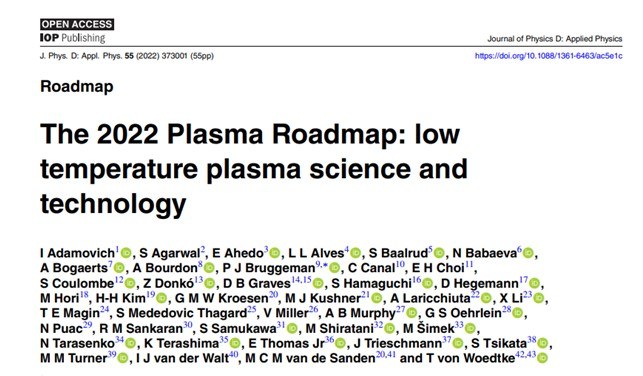PlasmaMed Lab contributes to settle "The 2022 Plasma Roadmap: low temperature plasma science and technology" by the Journal of Physics
Jul 28, 2022
The Journal of Physics D: Applied Physics (IOPscience) has recently published "The 2022 Plasma Roadmap: low temperature plasma science and technology", as part of a series of Plasma Roadmaps, with the intent to identify important outstanding challenges in the field of low-temperature plasma (LTP) physics and technology. Dr. Cristina Canal has been one of the 41 leading experts to settle this Roadmap.
The Journal of Physics D: Applied Physics (IOPscience) has recently published "The 2022 Plasma Roadmap: low temperature plasma science and technology", as part of a series of Plasma Roadmaps with the intention of identifying outstanding challenges and provide guidance to the field of LTP physics and technology for colleagues, funding agencies, and government institutions.
Dr. Cristina Canal, head of PlasmaMed Lab, has been one of the 41 leading experts representing 21 countries and five continents in the various sub-fields of LTP science and technology contributing to this Roadmap, which has the intent to identify important outstanding challenges in the field of low-temperature plasma (LTP) physics and technology.
The Journal of Physics D: Applied Physics published the first and second Plasma Roadmap in 2012 and 2017, respectively. The 2022 Roadmap follows a similar structure and it focuses on LTPs (Low Temperature Plasmas), that are usually generated by applying a voltage difference across electrodes to a gas or liquid.
In the last few decades, LTP science and technology has made a tremendous impact on our society. In view of the increasing interest in additive manufacturing (AM) and plasma processing of soft materials (including biomaterials),two new sections on these topics have been included. Since the LTP field has also actively responded to the challenges introduced by the COVID-19 pandemic, there is also a new dedicated section on this topic, among other added sections.
As stated in the introduction, "The recent achievements of our community highlighted in the Roadmap define the LTP community as a highly innovative field with many advances in a broad range of applications. The exceedingly broad range of societal impact areas from space exploration to health care and sustainability and energy applications provides our community with opportunities to continue to diversify our research field while recognizing that targeted new efforts and initiatives for diversifying the researcher demographics would be welcome. While more opportunities for interdisciplinary collaborations will without doubt enhance the societal impact from our field, there remains, however, a continued need to invest in fundamental plasma science to enable the development of the next generation of technologies that can address grand societal challenges related to sustainability, energy and health" (...) "Our community could benefit from more intense collaborations between experts working on plasma source development, diagnostics, and modeling and include more systematically sensitivity analysis and uncertainty quantification approaches. Developing such frameworks and more accessible computational and experimental capabilities would also enable us to more effectively train a new generation of scientists in fundamental LTP science that would be able to tackle many societal challenges in the coming decades and would be well placed to take on leadership roles in academia, research institutes and private R&D."

Share: